 Bryant University is a 125-year-old — but thoroughly modern — business- and liberal arts-oriented school located in Smithfield, Rhode Island (top photo). The 3,000- student institution has gained an enviable reputation for its career-directed educational opportunities, with both traditional undergraduate programs such as accounting and finance as well as contemporary curricula like information technology. Its graduate school offers MBA and MS degrees and began an MS in Information Systems program a few years ago.
Bryant University is a 125-year-old — but thoroughly modern — business- and liberal arts-oriented school located in Smithfield, Rhode Island (top photo). The 3,000- student institution has gained an enviable reputation for its career-directed educational opportunities, with both traditional undergraduate programs such as accounting and finance as well as contemporary curricula like information technology. Its graduate school offers MBA and MS degrees and began an MS in Information Systems program a few years ago.
Bryant’s campus is relatively new (relocated from Providence in 1970), so its facilities include amenities that you’d expect of find in today’s business schools. There’s an extensive computer lab and library (Figure 1), a realistic securities “trading floor” complete with ticker boards (Figure 2) and, of course, campus-wide Internet access, since all students are provided with laptops upon admission. An up-todate server farm connects the entire network (Figure 3).
 Figure 1. Main computer library in Bryant's George F. Bello Center for Information and Technology. Photo shows only a small fraction of the computers and other sensitive electronic equipment housed on campus. Understandably, the electrical system is rich in harmonics.
Figure 1. Main computer library in Bryant's George F. Bello Center for Information and Technology. Photo shows only a small fraction of the computers and other sensitive electronic equipment housed on campus. Understandably, the electrical system is rich in harmonics.  Figure 2. Finance students prepare for Wall Street jobs in a computer-equipped "trading floor." To add realism, terminals are networked with ticker boards on rear wall.
Figure 2. Finance students prepare for Wall Street jobs in a computer-equipped "trading floor." To add realism, terminals are networked with ticker boards on rear wall. 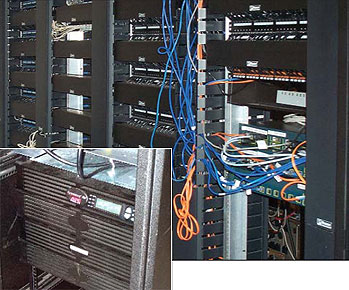 Figure 3. Server racks located in the Bello Center. The entire campus is networked from this location, for which power quality is maintained at the highest possible level by adherence to IEEE Recommended Practices. An uninterruptible power supply (lower photo) protects the network in the event of unscheduled outages.
Figure 3. Server racks located in the Bello Center. The entire campus is networked from this location, for which power quality is maintained at the highest possible level by adherence to IEEE Recommended Practices. An uninterruptible power supply (lower photo) protects the network in the event of unscheduled outages.Computers also manage the campus’ mechanical, electrical and safety systems, including lighting control, fire and security alarms and real-time Internet-based monitoring of the HVAC system’s chiller. For a description of how Bryant saves energy, read the CDA publication, Bryant University Saves Energy, Cuts Costs with All-Copper Systems.
Back to TopHarmonics Abound
With all that computer hardware, the school’s electrical system is understandably rich in harmonics. The switchedmode power supplies found in computers and similar “sensitive electronic equipment” are potent sources of these pesky waveform disturbances. Other common sources include variable frequency motor drives and electronic lighting ballasts, and Bryant has plenty of both. It has been estimated that a typical desktop computer with laser printer generates 140% total harmonic distortion (THD) and a third-harmonic content of 91%. The third and odd multiples of it (9th, 15th, 21st, etc.) are the so-called triplen harmonics. 1,2
The annoying consequences of harmonic distortion are nuisance tripping of circuit-breakers, reduced voltage, overheating of transformers and other signs of poor power quality. Unless controlled, harmonics can also damage the sensitive equipment that generates them. The most hazardous feature of triplen harmonics is that the currents they induce are additive on the neutral conductor in three-phase systems. In a harmonic-rich circuit, the magnitude of neutral currents can be as much as 1.7 times those of the phase current. Unless precautions are taken, those currents can lead to overheating and the potential risk of fire.
Fortunately, power-quality problems associated with harmonics are fairly well understood today, and effective strategies for dealing with them are readily available in such publications as the Institute for Electrical and Electronic Engineering’s standards IEEE Std. 142 (the “Green Book”) and IEEE Std. 1100 (the “Emerald Book”), plus the equally valuable Telecommunications Industry Association/Electronic Industry Association standard TIA/EIA-607, among others. These publications spell out the recommended practices applied by electrical systems designers wherever power quality issues are likely to arise. With its large computer load, Bryant University’s electrical system is one of those places.
Back to TopUpgrades Often Needed
The need for high power quality in computer-intensive environments has become increasingly recognized over the past several years. Prior to the ubiquity of computer equipment, few electrical systems contained the power quality features embodied in IEEE’s Recommended Practices. Compounding the potential problem at schools like Bryant University is the fact that building functions often change over time. Structures that may house mainly linear loads, such as incandescent lighting, might be recast as computer labs or medical clinics, which have far more stringent electrical requirements. If electrical systems aren’t upgraded during reconstruction, trouble in the form of poor power quality is the almost inevitable result.
Most of Bryant’s current campus was built just as PCs began finding their way into classrooms, and upgrades became increasingly necessary as the proportion of nonlinear loads increased. That doesn’t apply to the school’s George F. Bello Center for Information and Technology, which was dedicated in 2002. Its electrical and grounding systems are up to snuff. But other buildings, including the dormitories, needed help.
And help is what they got, thanks to Bill Gilmore, Bryant University’s director of campus planning. One of his first tasks was to install a double-ended utility feed. That provided improved reliability at very little extra cost. Reliability increased further when Bryant had the new feeders, as well as all other feeders on campus, installed underground.
And, he insisted they all be 100% copper. With his many years of marine service, Mr. Gilmore knows about corrosion. “I’ve had too many years experience with what can happen to aluminum,” he says, “and that’s why I specify copper all the time. Since 1988, when we eliminated all aluminum, we have not had a major electrical outage on campus, attributed to the on campus system.
But that was just the beginning. Recognizing that harmonics would lead to other problems down the road, Mr. Gilmore sought upgrades to the campus electrical system. Those upgrades closely follow IEEE and TIA/EIA recommended practices:
- To begin with, all distribution transformers on campus are K-13 rated (Figure 4). K-13 is the factor generally recommended for harmonic distortion levels associated with telecommunications equipment, classrooms and medical equipment. K-rated transformers are built with larger neutrals and additional cooling to withstand the additional heating of harmonics, while the electrostatic shield reduces the amplitude of noise reflected into the circuit. Bryant University further specifies copper- wound transformers, for increased efficiency and reliability. This, in turn, reduces the load on HVAC equipment, thus saving additional energy.
 Figure 4 . Distribution transformers at Bryant University are K-13 rated to accommodate the electrical system's high harmonic content
Figure 4 . Distribution transformers at Bryant University are K-13 rated to accommodate the electrical system's high harmonic content- Branch circuits containing computers and other sensitive loads (nonlinear) are separate from those used for other motors and other linear loads. Each set of circuits is served by separate panels.
- Branch circuits in computer facilities are limited to two outlets apiece. That might seem excessive, but reducing the number of outlets (i.e., increasing the number of branch circuits) limits the density of harmonics on those circuits. That reduces the magnitude of neutral currents, both in the branches and in feeders, and reduces possible interaction between equipment.
- Along those same lines, Mr. Gilmore called for doublesize neutrals in feeder circuits, and the use of AFC Super NeutralTM cables, which have larger neutrals, in branch circuits. Full-size ground wires (equal in size to the phase wires) were used throughout (Figure 5).
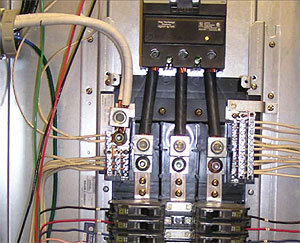 Figure 5. Neutrals in feeder circuits are doubled (upper left) and oversized in branch circuits (lower right) to accommodate harmonics. Neutral currents can be as high as 1.7 times the phase current in harmonic-rich circuits, and panels rated for 200% neutrals are a wise investment.
Figure 5. Neutrals in feeder circuits are doubled (upper left) and oversized in branch circuits (lower right) to accommodate harmonics. Neutral currents can be as high as 1.7 times the phase current in harmonic-rich circuits, and panels rated for 200% neutrals are a wise investment.- All panels are fitted with copper buses to avoid both the potential for bimetallic corrosion and the possibility of loose connections. Panels are also rated for 200% neutrals, as shown in Figure 6.
 Figure 6. Copper buses are used exclusively in panels. Since all feeders at Bryant are copper, this use of copper bus avoids the potential for galvanic corrosion, while also ensuring that connections remain tight.
Figure 6. Copper buses are used exclusively in panels. Since all feeders at Bryant are copper, this use of copper bus avoids the potential for galvanic corrosion, while also ensuring that connections remain tight.- New feeders and branch circuits were added to Bryant’s library to carry the added electrical load caused by computers and increased HVAC use. Because of limited floor space in electrical closets, new transformers were suspended overhead (Figure 7). The K-rated transformers run cool, so there was no overheating problem in the closets.
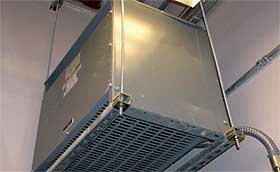 Figure 7. New K-rated transformers were suspended from overheads when the electrical system in Bryant's library was upgraded. The cool-running, all-copper transformers did not substantially add to heat loads in electrical closets.
Figure 7. New K-rated transformers were suspended from overheads when the electrical system in Bryant's library was upgraded. The cool-running, all-copper transformers did not substantially add to heat loads in electrical closets.- One of the many energy-saving steps employed at Bryant is the use of variable frequency drives on pump and blower motors. VFDs are strong harmonic generators. While the motor circuits to which they are connected are isolated from circuits containing computer loads, it is important that these harmonics be dealt with in order to protect the motor. This is accomplished by inserting harmonic-compensated reactors (Figure 8) which act somewhat like 1:1 filter transformers. Placed on the load side of the VFD, the reactors reduce the harmonic burden to the motor, raising its efficiency and enabling it to run cooler, thus extending its life. Noise is reduced as well. Harmonics on the line side of the VFD are trapped in K-rated distribution transformers.
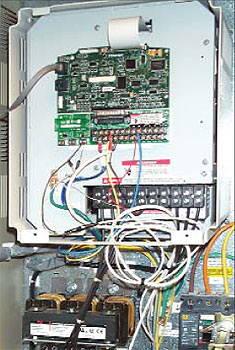 Figure 8. Harmonic-compensated reactors trap harmonics generated by VFDs in motor circuits. The copper-wound reactors enable motors to operate cooler, quieter and at higher efficiency.
Figure 8. Harmonic-compensated reactors trap harmonics generated by VFDs in motor circuits. The copper-wound reactors enable motors to operate cooler, quieter and at higher efficiency.- All transformers are protected against lightning strikes. Bryant is located at the top of a small mountain ridge at the north end of a valley and is subject to numerous lighting strikes. Gilmore therefore installed a complete copper ground grid around all high voltage transformers, Figure 9. Rooftop air terminals, lightning conductors and grounding electrodes are all-copper, ensuring connections remain tight, increasing reliability.
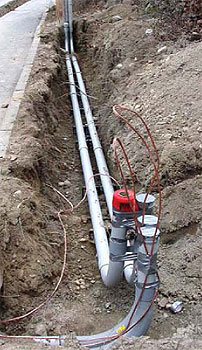 Figure 9.Because Bryant University is located on top of a small ridge and is subject to frequent lightning strikes, Bill Gilmore installed full copper ringgrounds around all high-voltage transformers. The additional copper ensures a robust, low-resistance ground for better lightning protection and exceeds codminimum requirements.
Figure 9.Because Bryant University is located on top of a small ridge and is subject to frequent lightning strikes, Bill Gilmore installed full copper ringgrounds around all high-voltage transformers. The additional copper ensures a robust, low-resistance ground for better lightning protection and exceeds codminimum requirements.- Feeders and branch circuits contain separate, full-size grounding conductors (green wires). Conduits and raceways are also part of the equipment grounding system, of course, but they are not used as primary ground paths since corrosion or loose connections — which can never be ruled out — would reduce their reliability.
Going Beyond Code
Reliable, high-quality power is important, particularly when 3,000 students depend on it every day, all day (and night). By adhering to IEEE Recommended Practices and staying ahead of potential problems, Bill Gilmore has made sure that the lights — and the computers and the safety systems — are always on at Bryant University.
Back to TopThe Principals
 William (Bill) Gilmore is director of campus planning at Bryant University, Smithfield, Rhode Island. By helping formulate, and then applying the university’s energy management program, he has succeeded in reducing energy consumption significantly while ensuring power quality. The costs avoided provide funds that benefit students and the university at large. Mr. Gilmore can be reached at 401- 232-6425, and via email at [email protected].
William (Bill) Gilmore is director of campus planning at Bryant University, Smithfield, Rhode Island. By helping formulate, and then applying the university’s energy management program, he has succeeded in reducing energy consumption significantly while ensuring power quality. The costs avoided provide funds that benefit students and the university at large. Mr. Gilmore can be reached at 401- 232-6425, and via email at [email protected]. Greg Gurney is Bryant University’s facilities engineer. A graduate of the Massachusetts Maritime Academy with more than a decade of shipboard experience, Mr. Gurney has learned, in the words of his management, how to make things work. Mr. Gurney can be reached at 401-232-6912, [email protected].
Greg Gurney is Bryant University’s facilities engineer. A graduate of the Massachusetts Maritime Academy with more than a decade of shipboard experience, Mr. Gurney has learned, in the words of his management, how to make things work. Mr. Gurney can be reached at 401-232-6912, [email protected].
Footnotes
 For a good introduction to harmonics and their effects, as well as recommended ways to deal with these voltage irregularities, see CDA’s Power Quality Primer section.
For a good introduction to harmonics and their effects, as well as recommended ways to deal with these voltage irregularities, see CDA’s Power Quality Primer section. See IEEE website.
See IEEE website.
